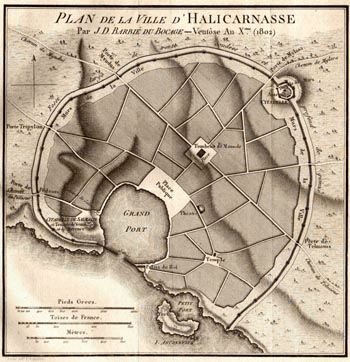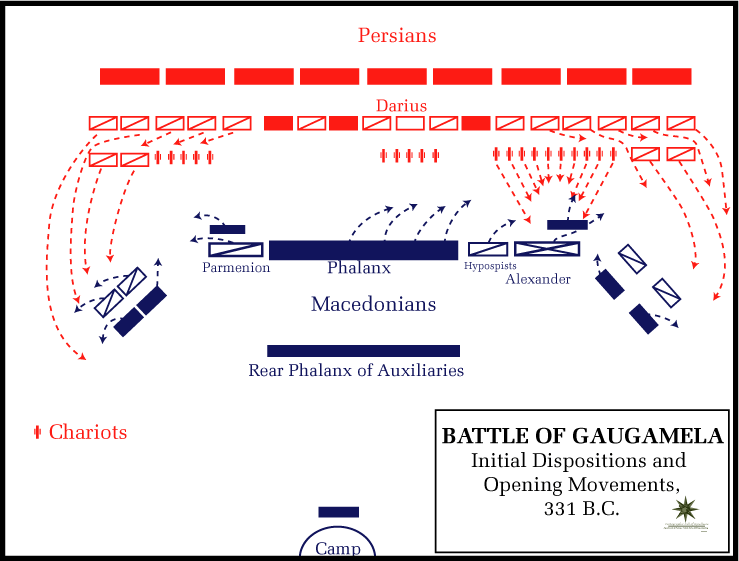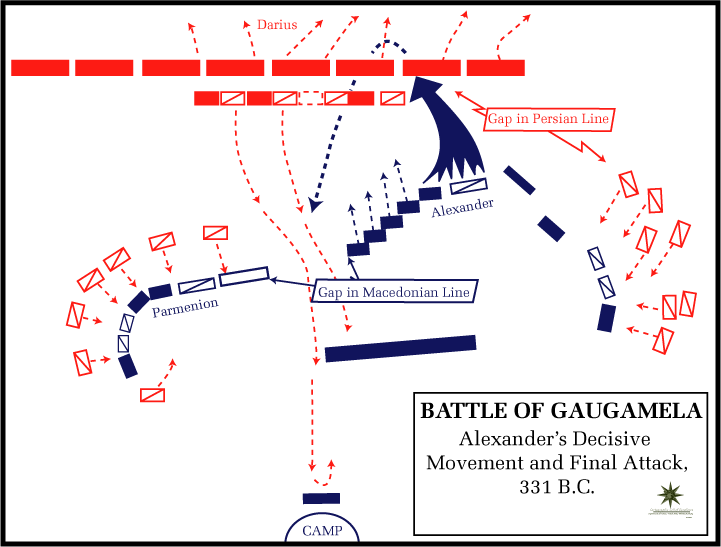Alexander's Campaign > Battle of Guagamela
Battle of Guagamela
Battle of Guagamela
Part of the Persian Campaign

Halicarnassus Map (1802)
Date: 1 October, 331 BC
Location: Gaugamela, Mesopotamia
Coordinates: 36.56°N 43.444°E
Aftermath: Macedonian victory
Territorial Changes: Alexander wins Babylon, half of Persia and all parts of Mesopotamia not already under his control.
Next Battle: Battle of Uxian Defile
Previous Battle: Siege of Gaza
Background
The Battle of Guagamela, also known as the Battle of Arbela was the decisive and final battle fought for control over the Achaemenid Empire between Alexander III the Great and Darius III on October 1st, 331 BCE. Following the loss at the Battle of Issus
Battle of Gaugamela (331 BCE)
The Battle of Gaugamela, also known as the Battle of Arbela, was a decisive confrontation between Alexander the Great and Darius III of Persia. Fought on October 1, 331 BCE, this battle marked the fall of the Persian Empire and solidified Alexander's reputation as one of history's greatest military commanders.
Background and Context
Alexander's Campaign:
- Previous Victories: After securing Asia Minor and winning crucial battles at the Granicus River and Issus, Alexander pushed deeper into the Persian Empire, aiming to capture its heartland.
- Strategic Objective: The decisive confrontation with Darius III was essential to dismantling Persian resistance and securing Alexander’s control over the entire empire.
Persian Preparations:
- Massive Army: Darius assembled a large and diverse army, drawing troops from across his vast empire. His forces included infantry, cavalry, and war elephants, significantly outnumbering Alexander’s army.
- Battlefield Choice: Darius chose the plains of Gaugamela near Arbela (modern-day Erbil, Iraq) for the battle, a location that favored his numerical superiority and allowed his chariots and cavalry to maneuver effectively.
The Battle
Army Composition:
- Alexander’s Forces: Alexander’s army consisted of approximately 47,000 troops, including the Macedonian phalanx, heavy and light cavalry, archers, and light infantry. His forces were well-trained, disciplined, and loyal.
- Darius’s Forces: Estimates suggest Darius’s army numbered between 100,000 and 1,000,000 soldiers, including a significant number of cavalry, chariots with scythe blades, and a large contingent of infantry.
Initial Deployment:
- Macedonian Formation: Alexander arranged his forces in a double line, with the phalanx in the center, heavy cavalry on the flanks, and light troops and archers in front. His second line was prepared to counter any flanking maneuvers by the Persians.
- Persian Formation: Darius placed himself at the center with his royal guard, surrounded by his best infantry. The wings were composed of cavalry and chariots, with war elephants positioned to break through enemy lines.
Engagement and Tactics:
- Skirmishes and Maneuvers: The battle began with skirmishes between the light troops and a series of cavalry charges. Alexander’s forces skillfully countered the initial Persian attacks, maintaining their formation.
- Feigned Retreat: Alexander employed a feigned retreat to draw Persian cavalry away from the main battlefield. This maneuver created a gap in the Persian lines, which Alexander exploited with a direct charge.
- Cavalry Charge: Leading his Companion Cavalry, Alexander launched a decisive charge through the gap in the Persian center, aiming directly for Darius. This bold move caused chaos and panic among the Persian troops.
Darius’s Flight:
- Breakdown of Persian Lines: As Alexander’s cavalry penetrated the Persian center, Darius, fearing capture, fled the battlefield. His departure demoralized his troops, leading to a collapse in Persian resistance.
- Macedonian Pursuit: Alexander’s forces pursued the fleeing Persians, inflicting heavy casualties. The disciplined Macedonian phalanx held firm against Persian attempts to regroup.
Aftermath and Significance
Decisive Victory:
- End of Persian Resistance: The Battle of Gaugamela effectively ended organized Persian resistance. Alexander’s victory dismantled the Persian military power and opened the way to the heart of the empire.
- Darius’s Fate: Darius fled eastward, attempting to rally support, but he was eventually betrayed and killed by his own satraps. His death marked the end of the Achaemenid dynasty.
Consolidation of Power:
- Capture of Capitals: Following Gaugamela, Alexander marched to capture the key Persian capitals of Babylon, Susa, Persepolis, and Ecbatana, seizing vast amounts of treasure and securing administrative control.
- Integration of Empire: Alexander adopted aspects of Persian administration and customs, integrating the conquered territories into his empire. He retained many Persian officials, blending Greek and Persian cultures.
Military Legacy:
- Tactical Brilliance: The Battle of Gaugamela showcased Alexander’s tactical brilliance, particularly his ability to adapt to battlefield conditions and employ innovative strategies. His use of feigned retreats and decisive cavalry charges exemplified his military genius.
- Psychological Impact: The victory at Gaugamela reinforced Alexander’s reputation as an invincible commander. It demoralized his enemies and bolstered the loyalty and morale of his troops.
Cultural Impact:
- Hellenistic Influence: The conquest of the Persian Empire led to the spread of Greek culture and ideas across the known world, initiating the Hellenistic Age. This cultural fusion had a lasting impact on art, architecture, science, and philosophy.
Conclusion
The Battle of Gaugamela was a pivotal moment in Alexander the Great’s conquests, marking the definitive fall of the Persian Empire and the rise of Alexander as the ruler of a vast and diverse empire. His tactical ingenuity and leadership at Gaugamela not only secured a decisive military victory but also paved the way for the cultural and administrative integration of the conquered territories. The battle remains one of the most studied and celebrated military engagements in history, exemplifying the genius of Alexander the Great.
The Battle

Battle of Guagamela Opening Movements - US Military Academy Ancient Warfare Atlas Index

Battle of Guagamela Decisive Movements - US Military Academy Ancient Warfare Atlas Index
| Combatants | |
|---|---|
| Achaemenid Empire | |
| Hellenic League | |
| Commanders | |
| Orontobates | |
| HepaestionCraterusParmenionPtolemyPerdiccasAntigonusCleitusNearchusSeleucusAristonSimmiasCoenusAristonGlauciasSopolis | Memnon of RhodesDarius IIIBessusMazaeusOrontes II †Atropates |
| Military Forces | |
| 47,000 | 52,000–120,000 (modern estimates) 250,000–1,000,000 (ancient sources) |
| Casualties | |
100 infantry and 1,000 cavalry (according to Arrian); 300 infantry (according to Curtius Rufus); 500 infantry (according to Diodorus Siculus) | 40,000 (according to Curtius Rufus) 47,000 (according to Welman) 90,000 (according to Diodorus Siculus) 300,000+ captured (according to Arrian) |
Sources
Warfare Links
- Agrianians
- Alexanders Military Structure
- Alexanders Military Tactics
- Alexanders Military Units
- Alexanders Military
- Antigonid Army
- Antigonid Military
- Antigonid Navy
- Argyraspides
- Baggage Train
- Bematist
- Companion Cavalry
- Greco Bactrian Military
- Hellenistic Armies
- Hellenistic Armor
- Hellenistic Battles
- Hellenistic Cavalary
- Hellenistic Chariots
- Hellenistic Diplomacy
- Hellenistic Fortifications
- Hellenistic Infantry
- Hellenistic Militaries
- Hellenistic Military Architecture
- Hellenistic Military Engineers
- Hellenistic Naval Battles
- Hellenistic Naval Warfare
- Hellenistic Navies
- Hellenistic Shields
- Hellenistic Siege Engines
- Hellenistic Siege Warfare
- Hellenistic Siege Weapons
- Hellenistic Spears
- Hellenistic Treaties
- Hellenistic Warships
- Hellenistic Weapons
- Hellensitic Helmets
- Hetairoi
- Hypaspists
- Hyrcanian Cavalry
- Macedonian Army
- Macedonian Phalanx
- Machimoi
- Metalleutes
- Paphlagonian Horsemen
- Persian Immortals
- Pezhetairos
- Phrourarchs
- Prodromoi
- Ptolemaic Army
- Ptolemaic Military
- Ptolemaic Navy
- Saka Mounted Archers
- Sarissa
- Sarissophoroi
- Seleucid Army
- Seleucid Battles
- Somatophylakes
- Sphendonetai
- Strategos
- Toxotai
- War Elephants